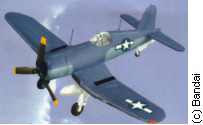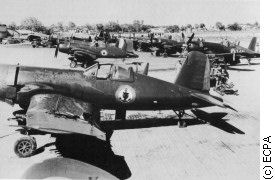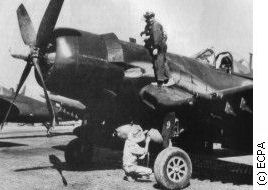|
At the height of the battle of Bien Bien Phu, the
exhausted Hellcat pilots of Flotille 11F were grounded for a month by
medical staff. The French high command scrambled to dispatch urgent
reinforcements and secured the loan of 25 USMC AU-1 Corsairs to be
flown by pilots of Flotille 14F, then working up in North Africa on the
Aéronavale’s newly-delivered F4U-7s. Flown to Indochina by
commercial charters, Flotille 14F’s aircrews took delivery of the
Korean veterans on May 25 and flew missions over Bien Bien Phu and the
Red River Delta until the ceasefire.
Available models
 While no AU-1
exists in 1/144 scale, it is possible to
convert an earlier
F4U-1 into a pseudo AU-1, i.e. something that will look close enough
outside of an IPMS contest. Until recently, the choice of 1/144
Corsairs was limited to
the Crown or Mitsuwa F4U-1 models in their various reincarnations.
While the Mitsuwa is less difficult to find, it is of very dubious
shape and portrays a very early aircraft with the birdcage canopy while
the
much
better Revell issue of the Crown kit is
long discontinued, much sought after and expensive. Things have now
improved thanks to the craze for 1/144 scale gashapon and the release by Bandai
of a F4U-1D in its Wing Club Series
2 line of pre-built collectible planes. Because this is the most
easily
available one (an Internet search should rapidly unearth one), this
article will focus on the Bandai model. While no AU-1
exists in 1/144 scale, it is possible to
convert an earlier
F4U-1 into a pseudo AU-1, i.e. something that will look close enough
outside of an IPMS contest. Until recently, the choice of 1/144
Corsairs was limited to
the Crown or Mitsuwa F4U-1 models in their various reincarnations.
While the Mitsuwa is less difficult to find, it is of very dubious
shape and portrays a very early aircraft with the birdcage canopy while
the
much
better Revell issue of the Crown kit is
long discontinued, much sought after and expensive. Things have now
improved thanks to the craze for 1/144 scale gashapon and the release by Bandai
of a F4U-1D in its Wing Club Series
2 line of pre-built collectible planes. Because this is the most
easily
available one (an Internet search should rapidly unearth one), this
article will focus on the Bandai model.
Model description
 The model
comes partly assembled with a choice of parts
to allow it to be finished in either flying or landed configurations.
As
a result, only the main landing gear doors, tail wheel doors, forward
radio antenna, canopy and seated pilot need to be glued to the
airframe.
As for dimensions, the length to wingspan ratio is accurate although
the model itself is a little big. The model
comes partly assembled with a choice of parts
to allow it to be finished in either flying or landed configurations.
As
a result, only the main landing gear doors, tail wheel doors, forward
radio antenna, canopy and seated pilot need to be glued to the
airframe.
As for dimensions, the length to wingspan ratio is accurate although
the model itself is a little big.
Surface detail is excellent throughout with thinly scribed panel lines
that throw old Crown models back in the stone age.
Surprisingly for such a detailed model, the leading edge oil and
intercoolers are simplified to the extreme and the wing slots back in
such a way as to suggest
that Bandai has possibly omitted a couple of parts to reduce costs.
| Dimensions: |
Wingspan |
Length |
| Plane (m) |
12.27 |
10.15 |
| Model (cm) |
8.56 |
7.15 |
| Scale |
1/143 |
1/142 |
Required modifications
 In order to
make this model look somewhat like an AU-1,
several features would need to be modified: propeller, engine cowling,
armament, canopy and aerials. In order to
make this model look somewhat like an AU-1,
several features would need to be modified: propeller, engine cowling,
armament, canopy and aerials.
Besides the propeller which needs to be
replaced by a
4-blade propeller to portray the Hamilton Standard unit, the main area
that should to be addressed is the oil
cooler
and intercooler inlets. Should you choose to proceed with this, the
best way is probably to restore the leading edge profile with
putty, imprint the inlet into the still soft putty then file to shape
when set. The lazy way out is to leave it alone and simply paint the
inlets at a later stage.
 The next area is
the engine cowling shape which
has the perfectly circular cross-section appropriate for an early
Corsair while the AU-1 had a cheek fairing on each side.
However, this is frankly not very noticeable and correcting it is a
rather difficult undertaking that is best avoided. The next area is
the engine cowling shape which
has the perfectly circular cross-section appropriate for an early
Corsair while the AU-1 had a cheek fairing on each side.
However, this is frankly not very noticeable and correcting it is a
rather difficult undertaking that is best avoided.
Four wing guns sleeves made from 1 mm plastic rod
will need to
replace
the existing armament, which is
strangely enough portrayed by three vertical slots on the leading edge
and not even close to anything seen on any Corsair wing. In addition,
ten 5 mm x 2 mm underwing pylons cut from thin
plastic card
should be added
along with stores from the spares box.
 While the
pre-painted canopy is obviously not the raised model found on the F4U-5
and later marks,
at least, it is a frameless canopy and makes a
very
passable rendition although adventurous types may undertake a full
conversion to an AU-1 canopy. While the
pre-painted canopy is obviously not the raised model found on the F4U-5
and later marks,
at least, it is a frameless canopy and makes a
very
passable rendition although adventurous types may undertake a full
conversion to an AU-1 canopy.
Finally, the
forward radio antenna mast should be removed, along with the stub mast
on top of
the
rudder, and a broad triangular antenna should be added aft of the rear
antenna mast which itself should be shortened.
Colours and markings
Since the AU-1 had a very short operational life in Indochina, options
are limited to an overall Gloss Dark Sea Blue (ANA 623, FS15042)
machine of Flotille 14F. However, because they were hastily repainted
by the US Navy and delivered under a crash program before being thrown
straight into the fray, no two Corsairs wore similar markings.
Upon delivery, tricolor roundels were hastily painted, initially
without
the regulation yellow surround. While fuselage
roundels were universal, wing roundels appear to have been worn under
the wings only on some aircraft while others sported full markings in
all four wing positions. Additional markings, such as the
Aéronavale's trademark "fishhook" anchor stenciled over the
cockades and the usual tricolour rudder, were painted as and when time
permitted and photographs show aircraft flown with these at various
stages of completion. Note that the Corsair profile at the top of this
page portrays an aircraft that came unusually close to full
markings since it is only missing the yellow surround to the cockades
and the individual aircraft number after its "14F-" flotilla markings.
As usual, decals will have to come from the spares box and rummaging
among 1/72 national markings for modern aircraft.
| Click
on the thumbnails below for full size images |

|
 |
Proof that hard
and fast rules are few and far between with regards to Corsair
markings: the three closest aircraft have roundels with yellow
surrounds while the next two have none. Note that the same "fishhook"
stencil has been used for the roundels and the rudder bands on the
second aircraft.
|
A poor quality
photograph, this nevertheless shows the very weathered appearence of
the battered Korean war veterans briefly used by Flotille
14F. |
 |
 |

|
| Some very varied
markings on display: the aircraft in the foreground has the anchor
stenciled over its roundels and work has started on the rudder with
a lone red band ; the second
aircraft still wears its original
roundels but seems to sport an overall red rudder; further along is a
Corsair
wearing a full tricolour rudder while to the right is the aircraft
portrayed in the profile at the top of this page. |
Not the best
quality photo, this shows the very rough appearance of the stencil used
to add the Aéronavale's anchor to the
original roundel. The roundel
appears to have a yellow surround (barely) apparent on the higher
resolution image.
Opposite the AU-1 is a C-47 of G.T. 1/64 Béarn wearing the black
undersurfaces adopted for night flying over Dien Bien
Phu.
|
A trio of
Corsairs on their way to Dien Bien Phu display the variety of markings
worn: the first
aircraft has had both anchors and tricolour rudder added, the second
only has anchors over the roundels and
the third only has a tricolour rudder. |
 |

|

|
This
photograph
shows to good effect the original roundel worn by the aircraft in the
background; it is also interesting to note that 14F-5 has its centre
wing section pylons loaded asymetrically with one 150 gallon tank and
one 1,000 lbs bomb.
|
Morroccan
tirailleurs load up 14F-12's wing
pylons with 500 lbs bomb. |
This
photo of
14F-9 undergoing final preparations before a mission
offer a good view of the big Hamilton Standard 4-blade propeller. |
Sources
- Patrick MARCHAND & Junko TAKAMORI, Les Corsair français :
F4U-7 & AU-1 (Les Ailes de la Gloire n.12), Editions
D'Along, Le Muy, ISBN 2-914403-14-8. Quite simply the most detailed
work on French operated Corsairs
- Jim SULLIVAN, F4U
Corsair in Action (Aircraft Number 145), Squadron/Signal
Publications, 1994, ISBN 0-89747-318-3
- Bert KINZEY, F4U
Corsair Part 1: XF4U through F2G (Detail and Scale Vol. 55),
Squadron/Signal Publications, 1998, ISBN 1-888974-08-7
- Bert KINZEY, F4U
Corsair Part 2: F4U-4 through F4U-7 (Detail and Scale Vol. 56),
Squadron/Signal Publications, 1998, ISBN 1-888974-08-7
- Barrett TILLMAN, Vought F4U Corsair (Warbird
Tech Series Vol. 4), Specialty Press, 1996, ISBN 0-933424-67-1
- René BAIL, Indochine, 1953-1954: les combats
de l'impossible, Charles-Lavauzelle, 1985, ISBN 2-70250-089-7
- René BAIL, Il
était une fois la 14 F, in Air Fan magazine n.72, 73, 74 and
76, October 1984 - February 1985
- Jean-Jacques PETIT, Des
Corsair
et des hameçons, in Air
Fan
magazine n.137, April 1990
- Jean-Marc
Poincin's Vought F4U-7 Corsair Walk Around on the Fanakit website (useful as
the F4U-7 shared the AU-1s fuselage)
Top - Home
|
|



 While no AU-1
exists in 1/144 scale, it is possible to
convert an earlier
F4U-1 into a pseudo AU-1, i.e. something that will look close enough
outside of an IPMS contest. Until recently, the choice of 1/144
Corsairs was limited to
the Crown or Mitsuwa F4U-1 models in their various reincarnations.
While the Mitsuwa is less difficult to find, it is of very dubious
shape and portrays a very early aircraft with the birdcage canopy while
the
much
better Revell issue of the Crown kit is
long discontinued, much sought after and expensive. Things have now
improved thanks to the craze for 1/144 scale gashapon and the release by Bandai
of a F4U-1D in its Wing Club Series
2 line of pre-built collectible planes. Because this is the most
easily
available one (an Internet search should rapidly unearth one), this
article will focus on the Bandai model.
While no AU-1
exists in 1/144 scale, it is possible to
convert an earlier
F4U-1 into a pseudo AU-1, i.e. something that will look close enough
outside of an IPMS contest. Until recently, the choice of 1/144
Corsairs was limited to
the Crown or Mitsuwa F4U-1 models in their various reincarnations.
While the Mitsuwa is less difficult to find, it is of very dubious
shape and portrays a very early aircraft with the birdcage canopy while
the
much
better Revell issue of the Crown kit is
long discontinued, much sought after and expensive. Things have now
improved thanks to the craze for 1/144 scale gashapon and the release by Bandai
of a F4U-1D in its Wing Club Series
2 line of pre-built collectible planes. Because this is the most
easily
available one (an Internet search should rapidly unearth one), this
article will focus on the Bandai model. In order to
make this model look somewhat like an AU-1,
several features would need to be modified: propeller, engine cowling,
armament, canopy and aerials.
In order to
make this model look somewhat like an AU-1,
several features would need to be modified: propeller, engine cowling,
armament, canopy and aerials.

 The model
comes partly assembled with a choice of parts
to allow it to be finished in either flying or landed configurations.
As
a result, only the main landing gear doors, tail wheel doors, forward
radio antenna, canopy and seated pilot need to be glued to the
airframe.
As for dimensions, the length to wingspan ratio is accurate although
the model itself is a little big.
The model
comes partly assembled with a choice of parts
to allow it to be finished in either flying or landed configurations.
As
a result, only the main landing gear doors, tail wheel doors, forward
radio antenna, canopy and seated pilot need to be glued to the
airframe.
As for dimensions, the length to wingspan ratio is accurate although
the model itself is a little big. The next area is
the engine cowling shape which
has the perfectly circular cross-section appropriate for an early
Corsair while the AU-1 had a cheek fairing on each side.
However, this is frankly not very noticeable and correcting it is a
rather difficult undertaking that is best avoided.
The next area is
the engine cowling shape which
has the perfectly circular cross-section appropriate for an early
Corsair while the AU-1 had a cheek fairing on each side.
However, this is frankly not very noticeable and correcting it is a
rather difficult undertaking that is best avoided.  While the
pre-painted canopy is obviously not the raised model found on the F4U-5
and later marks,
at least, it is a frameless canopy and makes a
very
passable rendition although adventurous types may undertake a full
conversion to an AU-1 canopy.
While the
pre-painted canopy is obviously not the raised model found on the F4U-5
and later marks,
at least, it is a frameless canopy and makes a
very
passable rendition although adventurous types may undertake a full
conversion to an AU-1 canopy.






